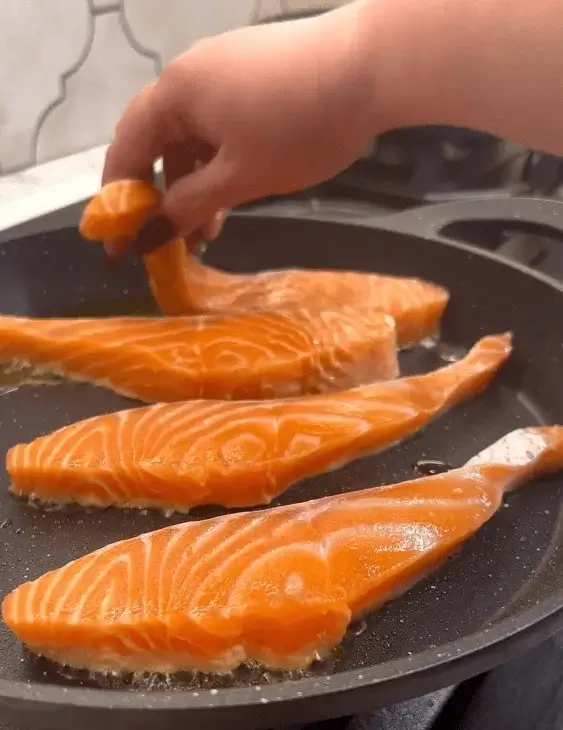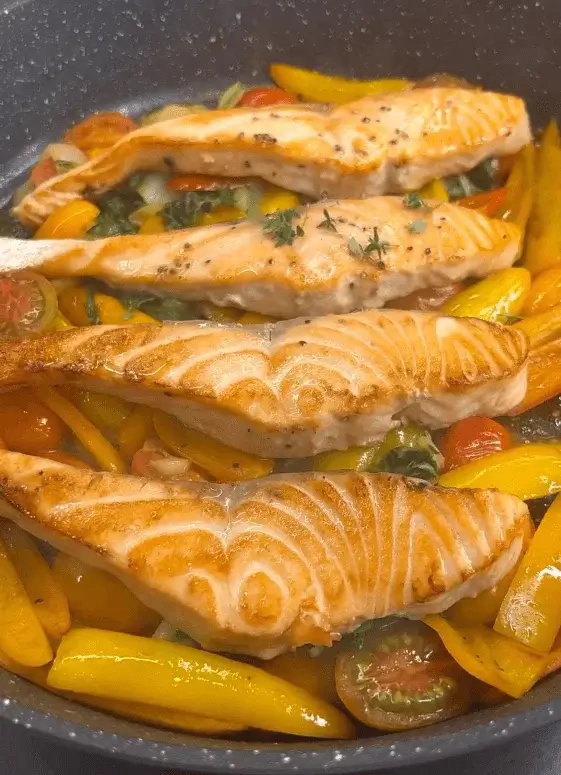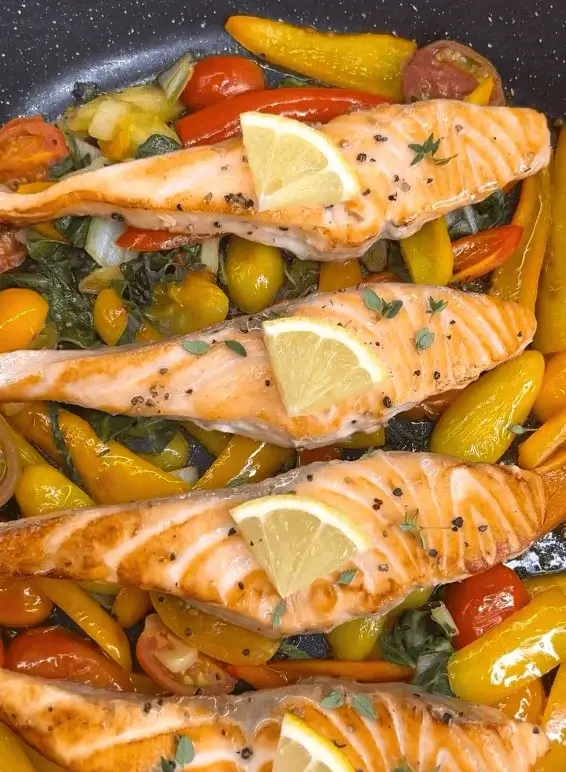Salmon in White Wine Sauce with Beet Greens and Cherry Tomatoes
We may earn a commission from recommended products, at no extra cost to you. See Disclosure.
INGREDIENTS
- 2.2 pounds/1 kilogram skinless salmon fillet, cut into 1.5 cm-thick slices
- 1 cup cherry tomatoes, halved
- 1 cup Tinkerbell peppers into strips
- 1 cup beet greens, thinly sliced
- ⅓ cup white wine
- 3 garlic cloves, thinly sliced
- 2 lemon slices cut into quarters
- ¼ cup olive oil
- 2 tablespoons honey
- ¾ teaspoon salt
- ¼ teaspoon ground black pepper
INSTRUCTIONS
- Heat up a pan with olive oil. Sear the salmon slices for a minute and a half on one side. Sprinkle with salt and pepper, drizzle a tablespoon of honey and brush to coat evenly. Flip to the other side and sear for another minute.
- Wipe down the pan, add some more olive oil and heat over medium heat. Fry the peppers, cherry tomatoes, and beet greens until soft but not too much. Add garlic and white wine, and cover for 5 minutes. Uncover and place the salmon slices on top of the vegetables. Drizzle with a tablespoon of honey, sprinkle with salt and ground pepper, and place lemon slices on the salmon. Sauté for another 2 minutes and turn off the heat.
MY NOTES

FAQ
What can I substitute for Tinkerbell peppers if I can’t find them?
If Tinkerbell peppers are unavailable, mini sweet peppers or small bell peppers are excellent alternatives. These peppers share a similar sweetness and mild flavor, complementing the dish’s overall taste. Slice or dice them to match the size of Tinkerbell peppers for consistent texture and appearance in your recipe. Alternatively, you could use cubanelle peppers or banana peppers for a slightly different flavor profile.


Can I use frozen fish to make this salmon in white wine sauce?
Yes, you can use frozen fish instead of fresh for this salmon in white wine sauce recipe. However, ensure it’s thoroughly thawed before cooking to ensure even cooking and optimal texture. To thaw frozen salmon safely, transfer it to the refrigerator overnight or use the defrost setting on your microwave. Once thawed, pat the salmon dry with paper towels before cooking to remove excess moisture, which can affect the searing process. Adjust cooking time as needed to account for any residual chill from the frozen salmon.
What can I serve this salmon in white wine sauce with?
Salmon in white wine sauce pairs wonderfully with a variety of sides to complement its flavors. Consider serving it alongside roasted vegetables such as asparagus, broccoli, or carrots for a nutritious and colorful accompaniment. Alternatively, opt for a refreshing salad with mixed greens, cherry tomatoes, and a light vinaigrette dressing to contrast the richness of the salmon. For a heartier option, serve the salmon with creamy mashed potatoes or fluffy quinoa for added texture and substance. Additionally, crusty bread or dinner rolls are perfect for soaking up any delicious sauce or juices from the salmon. Choose sides based on personal preference and dietary considerations.


How can I prevent the salmon from sticking to the pan?
To prevent salmon from sticking to the pan, start with a clean, dry pan and preheat it over medium-high heat. Add a thin layer of oil with a high smoke point, such as vegetable or grapeseed oil. Ensure the oil is evenly distributed across the pan’s surface. Pat the salmon dry with paper towels before placing it in the pan to remove excess moisture. Place the salmon in the pan skin-side down, if applicable, and avoid moving it until it develops a golden crust, usually 3-4 minutes. Use a fish spatula to gently flip the salmon and continue cooking until done, adjusting the heat if necessary.

Can I marinate the salmon ahead of time?
Yes, you can marinate the salmon ahead of time to enhance its flavor. Prepare the marinade according to the recipe instructions, then place the salmon fillets in a shallow dish or resealable plastic bag. Pour the marinade over the salmon, ensuring it’s evenly coated. Cover the dish or seal the bag tightly, then refrigerate for up to a few hours before cooking. Avoid marinating the salmon for too long, as prolonged exposure to acidic ingredients like lemon juice or vinegar can break down the fish’s texture. For best results, aim for a marinating time of 30 minutes to 2 hours before cooking.

